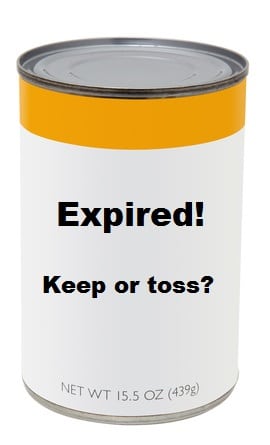Stop throwing out perfectly good food!
If you’re like most people, you’ve probably wondered from time to time if the expiration dates listed on your food really indicate that it’s no longer good, or if the date actually is telling you something else. The truth is, the viable shelf life of foods often are not necessarily what’s listed on the package.
Much of product dating comes from the fact that manufacturers need to label consumable goods with some kind of dating system. It is expected by consumers and is a way to help manufacturers protect themselves, and track their products if anything goes wrong.
The good news is, you can hack this system by understanding product dating style variances, and the natural shelf life of your favorite foods.
Food dating mainly follows one of four product dating styles:
Expiration dates: We’ll refer to this is a straight expiration date. Manufacturers can choose to use a straight expiration date in order to give consumers reliable information for food safety purposes. But even these dates may not be completely accurate. Many manufacturers use what they have determined to be a safety date through product testing. They then label every new product as it is manufactured with identical time lengths of food freshness from the time of production.
For example, if a manufacturer has determined that a product will be good for up to two months, and production is on the 15th of the month, the expiration date will read the 15th of the month exactly two months from the date of packaging; products produced on the 16th will have the 16th of the month exactly 2 months from the date of packaging; and so on. Because straight expiration dates rely on product testing, they may not necessarily indicate food safety perfectly.
“Sell by” dates: “Sell by” dates only list the length of time that a product can be displayed for sale. This dating system does not give any accurate indication as to the length of time the food can safely be consumed.
“Best if used by (or before)” dates: Similar to straight expiration dates, these dates only indicate the manufacturers determined length of time for recommended best flavor or quality. It is not an indication of food safety, or even the date a food should be purchased by. The manufacturer is indicating that the product will remain fresh and at its best quality up to that date. The date does not mark when the food is no longer safe to eat; only that it might not taste as good, or the texture could be slightly different. (Such as chips that aren’t as crisp anymore.)
“Use by” dates: Use By dates are the last day recommended for the use of the product to ensure peak quality. Similar to both “straight expiration dates” and “Best if used by (or before)” dates, these dates are determined by the manufacturer, through testing, to ensure the highest quality at consumption. The product very well could still be good, and safe, long after the printed date.
How do you know for sure if food is still safe to eat?
Since expiration dates can give you some indication of the freshness and safety of food, how can you truly know when you can still use a product or you need to throw it out?
One helpful resource to assess the safety of a product is StillTasty.com. This website includes numerous articles on food safety, food storage, and determining if a product is still good. They maintain a “Keep it or Toss it” database that is quite useful. Enter your food in question (opened or unopened) and they will give you recommendations based on the products general “use by date”, as well as guidelines for smell, taste, and appearance. Similarly, USDA.gov has numerous articles about food safety, freezing, thawing, understanding labels, and more.
Combining understanding date stamping, with online resources and your own intuition, can save you a significant amount of money. With the emphasis on food safety in the United States, Americans tend to throw away a lot of money when they only follow package dates.
We fully endorse food safety and are grateful for the guidelines we have here in the U.S. We also fully support being smart with finances and recommend giving foods a once-over before just tossing and re-buying new. Of course, we do temper this with a word of caution: While food can generally be kept safely well behind the stamped date, if it has been mishandled in any way (for example, left out at room temperature too long), proceed with caution due to potential contamination. If something is wrong with the look, smell, and/or taste, dispose of it, no matter what the date stamped on the product says. Your health is most important!



